Palletizing Robot Market
Palletizing Robot Market Size and Share Forecast Outlook 2025 to 2035
Palletizing robot market is projected to grow from USD 2.9 billion in 2025 to USD 5.4 billion by 2035, at a CAGR of 6.4%. Articulated will dominate with a 0.0% market share, while 30–120 pallets/day will lead the throughput segment with a 54.0% share.
Palletizing Robot Market Forecast and Outlook 2025 to 2035)
The palletizing robot industry stands at the threshold of a decade-long expansion trajectory that promises to reshape specialty logistics applications, automated packaging enhancement, and warehouse automation solutions across food & beverage operations, e-commerce fulfillment, and specialty pharmaceutical sectors.
The market's journey from USD 2.9 billion in 2025 to USD 5.4 billion by 2035 represents substantial growth,the market will rise at a CAGR of 6.4% which demonstrating the accelerating adoption of automated palletizing systems and advanced robotic packaging solutions across food & beverage manufacturing, e-commerce logistics, and specialty pharmaceutical sectors.
Quick Stats for Palletizing Robot Market
- Palletizing Robot Market Value (2025): USD 2.9 billion
- Palletizing Robot Market Forecast Value (2035): USD 5.4 billion
- Palletizing Robot Market Forecast CAGR: 6.4%
- Leading Robot Type in Palletizing Robot Market: Articulated
- Key Growth Regions in Palletizing Robot Market: North America, Europe, and Asia Pacific
- Top Key Players in Palletizing Robot Market: FANUC, ABB, KUKA, Yaskawa, Kawasaki
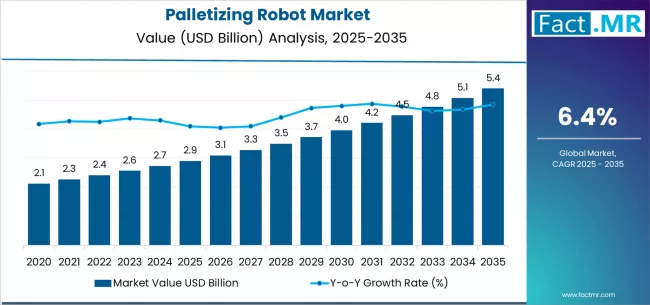
The first half of the decade (2025-2030) will witness the market climbing from USD 2.9 billion to approximately USD 3.8 billion, adding USD 0.9 billion in value, which constitutes 33% of the total forecast growth period. This phase will be characterized by the rapid adoption of articulated robot systems, driven by increasing demand for flexible palletizing automation and the growing need for efficient packaging solutions worldwide. Advanced robotic capabilities and flexible automation systems will become standard expectations rather than premium options.
The latter half (2030-2035) will witness sustained growth from USD 3.8 billion to USD 5.4 billion, representing an addition of USD 1.6 billion or 67% of the decade's expansion. This period will be defined by mass market penetration of specialized palletizing robot technologies, integration with comprehensive warehouse platforms, and seamless compatibility with existing logistics infrastructure. The market trajectory signals fundamental shifts in how producers approach packaging automation optimization and palletizing system quality management, with participants positioned to benefit from sustained demand across multiple application types and distribution segments.
The convergence of AI-based motion control, digital twin simulations, and predictive maintenance algorithms is set to redefine efficiency benchmarks in palletizing operations. These technologies will enhance accuracy, reduce downtime, and enable real-time performance optimization across automated packaging lines. Collaborative palletizing robots (cobots) are also gaining prominence, allowing seamless human–machine interaction while improving workplace safety and flexibility in mixed-load environments.
Emerging economies, particularly across Asia-Pacific and Latin America, are projected to become key demand hubs as manufacturers modernize production infrastructure and embrace automation to meet rising export and domestic requirements. Furthermore, sustainability imperatives are shaping procurement and design choices, with companies prioritizing energy-efficient robots, lightweight pallet configurations, and recyclable packaging materials.
Integration with cloud-based warehouse management systems and Industrial IoT platforms will further unlock data-driven decision-making, predictive analytics, and remote system monitoring. Collectively, these advancements will transform palletizing robots from task-specific tools into intelligent, adaptive automation assets that serve as critical enablers of smart logistics and sustainable supply chain ecosystems.
Beyond efficiency and sustainability, the next growth phase will emphasize customization and scalability in palletizing robot systems. Manufacturers are increasingly demanding modular designs that can be reconfigured quickly to handle varying product dimensions, packaging types, and load patterns without extensive downtime.
This trend aligns with the shift toward flexible manufacturing and shorter product life cycles in consumer goods and e-commerce sectors. End-of-line automation is being augmented with advanced vision systems and machine learning algorithms that enable robots to recognize irregular shapes and optimize stacking precision. As these capabilities mature, palletizing robots will become central to fully autonomous, high-throughput warehouse ecosystems worldwide.
Palletizing Robot Market Year-over-Year Forecast (2025-2035)
The Palletizing Robot market demonstrates distinct growth phases with varying market characteristics and competitive dynamics. Between 2025 and 2030, the market progresses through its warehouse automation adoption phase, expanding from USD 2.9 billion to USD 3.8 billion with steady annual increments averaging 6.4% growth. This period showcases the transition from conventional manual palletizing to advanced robot-based systems with enhanced flexibility capabilities and integrated control systems becoming mainstream features.
The 2025-2030 phase adds USD 0.9 billion to market value, representing 33% of total decade expansion. Market maturation factors include standardization of warehouse automation and logistics protocols, declining component costs for specialized robotic equipment, and increasing industry awareness of automation benefits reaching 95-98% operational effectiveness in food & beverage and e-commerce applications. Competitive landscape evolution during this period features established robotics companies like FANUC and ABB expanding their palletizing portfolios while specialty manufacturers focus on advanced automation development and enhanced flexibility capabilities.
From 2030 to 2035, market dynamics shift toward advanced automation integration and global logistics distribution expansion, with growth continuing from USD 3.8 billion to USD 5.4 billion, adding USD 1.6 billion or 67% of total expansion. This phase transition centers on specialized palletizing robot systems, integration with automated warehouse networks, and deployment across diverse food, e-commerce, and pharmaceutical scenarios, becoming standard rather than specialized applications.
Palletizing Robot Market Key Takeaways
At-a-Glance Metrics
| Metric | Value |
|---|---|
| Market Value (2025) → | USD 2.9 billion |
| Market Forecast (2035) ↑ | USD 5.4 billion |
| Growth Rate ★ | 6.4% CAGR |
| Leading Robot Type → | Articulated Systems |
| Primary Industry → | Food & Beverage |
The market demonstrates strong fundamentals with food & beverage applications capturing a dominant share through advanced packaging automation and efficiency enhancement capabilities. Articulated robot systems drive primary performance, supported by increasing warehouse automation adoption and specialty logistics trends.
Geographic expansion remains concentrated in developed markets with established logistics infrastructure, while emerging economies show accelerating adoption rates driven by automation consciousness and rising efficiency standards.
Why is the Palletizing Robot Market Growing?
Market expansion rests on three fundamental shifts driving adoption across the food & beverage, e-commerce, and pharmaceutical sectors. First, labor shortage mitigation creates compelling operational advantages through palletizing robots that provide immediate automation benefits without workforce dependency, enabling operators to meet production requirements while maintaining consistency and reducing operational complexity. Second, warehouse automation development accelerates as specialty logistics facilities worldwide seek advanced robotic systems that complement traditional material handling operations, enabling precise palletizing control and quality assurance that align with industry standards and efficiency requirements.
Third, throughput optimization drives adoption from packaging facilities and specialty operators requiring effective palletizing systems that maximize productivity benefits while maintaining operational reliability during high-volume packaging and distribution scenarios. However, growth faces headwinds from initial investment considerations that vary across automation suppliers regarding the cost of robotic systems and integration requirements, which may limit adoption in capital-sensitive environments. Technical limitations also persist regarding product variability and handling complexity that may reduce effectiveness in diverse packaging environments, which affect system flexibility and adaptation capabilities.
Opportunity Pathways - Palletizing Robot Market.
The palletizing robot market represents a warehouse automation opportunity driven by expanding logistics trends, e-commerce modernization, and the need for superior packaging effectiveness in diverse industrial applications. As operators worldwide seek to achieve 95-98% packaging effectiveness, reduce labor dependency, and integrate advanced robotic systems with warehouse platforms, palletizing robots are evolving from specialty equipment to sophisticated automation solutions ensuring operational quality and efficiency benefits.
The market's growth trajectory from USD 2.9 billion in 2025 to USD 5.4 billion by 2035 at a 6.4% CAGR reflects fundamental shifts in logistics preferences and automation optimization. Geographic expansion opportunities are particularly pronounced in North American markets, while the dominance of food & beverage applications (41.0% market share) and articulated robot types (48.0% share) provides clear strategic focus areas.
Pathway A - Articulated Robot Leadership & Advanced Packaging Optimization. Strengthening the dominant articulated robot segment (48.0% market share) through enhanced system formulations, superior flexibility content, and automated control systems. This pathway focuses on optimizing packaging flexibility, improving robot consistency, extending operational effectiveness to 95-98% success rates, and developing specialized formulations for diverse logistics applications. Market leadership consolidation through advanced robotic engineering and integrated warehouse systems enables premium positioning while defending competitive advantages against alternative robot systems. Expected revenue pool: USD 390-520 million
Pathway B - Food & Beverage Application Expansion & Market Localization. Rapid food processing and beverage manufacturing growth across global markets creates substantial expansion opportunities through specialized packaging capabilities and industry partnerships. Growing automation consciousness and efficiency trends drive sustained demand for advanced palletizing robot systems. Application strategies reduce operational costs, enable superior packaging performance, and position companies advantageously for food industry programs while accessing growing manufacturing markets. Expected revenue pool: USD 332-442 million
Pathway C - 30-120 Pallets/Day Throughput Dominance & Efficiency Integration. Expansion within the dominant 30-120 pallets/day segment (54.0% market share) through specialized throughput management addressing medium-volume operations and operational requirements. This pathway encompasses mid-range automation systems, throughput optimization, and compatibility with diverse warehouse platforms. Premium positioning reflects superior efficiency and comprehensive throughput compliance supporting modern logistics commerce. Expected revenue pool: USD 437-583 million
Pathway D - Delta/Parallel Robot Diversification. Strategic expansion into delta/parallel robot applications (29.0% market share) requires enhanced speed capabilities and specialized processing addressing high-speed operational requirements. This pathway addresses rapid packaging, speed applications, and integration with advanced processing for demanding logistics conditions. Premium pricing reflects specialized performance requirements and speed efficiency standards. Expected revenue pool: USD 235-313 million
Pathway E - E-commerce Market Innovation. Development of specialized palletizing robot applications for e-commerce sector (36.0% share), addressing specific fulfillment requirements and distribution demands. This pathway encompasses fulfillment center systems, distribution applications, and cost-effective alternatives for e-commerce markets. Technology differentiation through proprietary design enables diversified revenue streams while reducing dependency on single application platforms. Expected revenue pool: USD 292-389 million
Pathway F - Pharmaceutical Application Development & Quality Integration. Expansion of pharmaceutical segment (23.0% market share) through enhanced quality properties, cleanroom applications, and specialized pharmaceutical requirements. This pathway encompasses pharmaceutical-grade development, cleanroom applications, and processed systems requiring quality characteristics. Market development through advanced quality engineering enables differentiated positioning while accessing markets requiring pharmaceutical solutions. Expected revenue pool: USD 186-248 million
Pathway G - SCARA/Gantry Development & Precision Integration. Development of SCARA/gantry systems addressing specialized precision requirements and structured operations across diverse logistics scenarios. This pathway encompasses precision positioning systems, structured applications, and comprehensive positioning documentation. Premium positioning reflects precision expertise and positioning capabilities while enabling access to precision-driven programs and accuracy-focused partnerships. Expected revenue pool: USD 186-248 million
Segmental Analysis
The market is segmented by robot type into Articulated, Delta/parallel, and SCARA/gantry categories, representing the evolution from simple positioning systems to specialized flexible solutions for comprehensive packaging optimization.
The throughput segmentation divides the market into 30–120 pallets/day, >120, and <30 sectors, reflecting distinct requirements for production performance, volume capacity, and operational efficiency specifications.
The industry segmentation covers Food & beverage, E-commerce, and Pharma categories, with food applications leading adoption while e-commerce applications show accelerating growth patterns driven by fulfillment expansion programs.
Why are Articulated Palletizing Robots Enjoying Elevated Popularity?
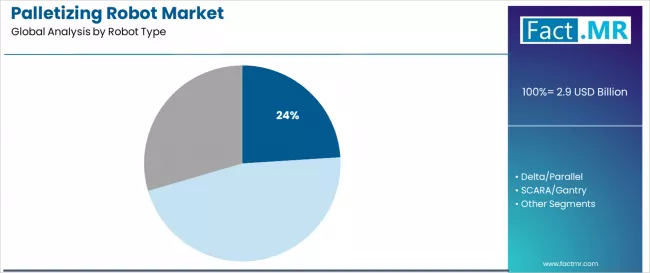
Articulated robots command the leading position in the palletizing robot market with approximately 48.0% market share through advanced flexibility features, including superior versatility content, flexible positioning capability, and packaging optimization that enable operators to achieve optimal palletizing benefits across diverse food & beverage and e-commerce environments.
The segment benefits from operator preference for reliable flexibility systems that provide consistent packaging performance, reduced product limitations, and operational efficiency optimization without requiring multiple specialized systems. Advanced flexibility features enable automated packaging systems, versatility control, and integration with existing warehouse equipment, where packaging performance and system adaptability represent critical operational requirements.
Articulated robot systems differentiate through proven flexibility stability, consistent versatility characteristics, and integration with automated warehouse systems that enhance operational effectiveness while maintaining optimal adaptability suitable for diverse food & beverage and e-commerce applications.
Key market characteristics:
- Advanced flexibility formulations with optimized articulated mechanisms and packaging capabilities
- Extended operational effectiveness, enabling 95-98% palletizing success with consistent packaging quality
- Warehouse compatibility, including automated control systems, efficiency monitoring, and process integration for food & beverage and e-commerce operations
Will the Scope for Delta/Parallel Palletizing Robots Increase?
Delta/parallel robot systems maintain a significant 29.0% market share in the palletizing robot market due to their specialized speed properties and high-throughput application advantages. These robots appeal to operators requiring rapid palletizing with consistent characteristics for high-speed applications, fast operations, and volume processing. Market growth is driven by e-commerce sector expansion, emphasizing rapid packaging solutions and operational speed through proven robotic systems.
By Throughput, Which Segment Accounts for the Largest Market Share?
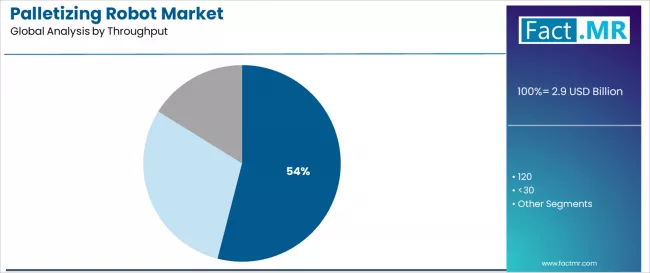
30-120 pallets/day palletizing robots dominate the palletizing robot market with approximately 54.0% market share due to widespread adoption of medium-volume automation platforms and increasing focus on balanced throughput systems, operational efficiency, and cost-effective automation applications that minimize traditional manual handling limitations while maintaining productivity quality standards.
Warehouse operators prioritize throughput balance, operational efficiency, and integration with existing logistics infrastructure that enables coordinated operations across multiple product categories. The segment benefits from substantial logistics investment and modernization programs that emphasize the acquisition of advanced robotic systems for efficiency improvement and operational optimization applications.
Balanced automation trends incorporate palletizing robots as optimal equipment for warehouse operations, while efficiency trends increase demand for advanced throughput capabilities that comply with productivity standards and minimize manual handling dependencies. Varying product requirements and throughput specifications may limit system standardization across different warehouse facilities or operational scenarios.
Why are >120 Pallets/Day Throughput Palletizing Robots Experiencing High-Volume Demand
120 pallets/day applications capture approximately 28.0% market share through specialized high-volume requirements in large-scale operations, high-capacity facilities, and intensive applications. These facilities demand robust robotic systems capable of operating in high-volume conditions while providing effective packaging performance and throughput reliability capabilities.
What are the Prospect for <30 Pallets/Day Throughput Palletizing Robots?
<30 pallets/day applications account for approximately 18.0% market share, including small operations, specialized packaging, and low-volume applications requiring palletizing robot capabilities for flexible operation and efficiency optimization.
What are the Drivers, Restraints, and Key Trends of the Palletizing Robot Market?
Warehouse automation trends drive primary adoption as palletizing robots provide advanced efficiency capabilities that enable logistics facilities to meet throughput demands without workforce dependency, supporting automation operations and productivity missions that require consistent palletizing applications.
Labor shortage consciousness accelerates market expansion as facilities seek effective robotic systems that minimize staffing challenges while maintaining operational effectiveness during packaging and distribution scenarios. Logistics spending increases worldwide, creating sustained demand for palletizing robot systems that complement traditional material handling processes and provide operational flexibility in complex warehouse environments.
Initial investment considerations vary across automation suppliers regarding the cost of robotic systems and integration requirements, which may limit operational flexibility and market penetration in regions with limited capital capacity or investment-sensitive logistics operations.
Product variability limitations persist regarding handling diversity and complexity factors that may reduce effectiveness in diverse packaging, varying products, or demanding handling conditions, affecting system flexibility and adaptation reliability. Market fragmentation across multiple robot specifications and industry standards creates compatibility concerns between different suppliers and existing warehouse infrastructure.
Adoption accelerates in food & beverage and e-commerce sectors where efficiency requirements justify palletizing robot system investments, with geographic concentration in developed markets transitioning toward mainstream adoption in emerging economies driven by logistics consciousness expansion and warehouse development. Technology development focuses on enhanced robotic capabilities, improved system flexibility, and integration with warehouse systems that optimize palletizing effectiveness and operational performance.
Analysis of the Palletizing Robot Market by Key Country
The palletizing robot market demonstrates varied regional dynamics with growth leaders including the USA (8.2% CAGR) and Mexico (7.8% CAGR) driving expansion through warehouse capacity additions and logistics development programs.
Steady performers encompass Germany (7.4% CAGR), France (7.0% CAGR), and South Korea (6.6% CAGR), benefiting from established logistics industries and advanced automation adoption. Mature markets feature UK (6.1% CAGR) and Japan (6.0% CAGR), where specialized applications and technology integration support consistent growth patterns.
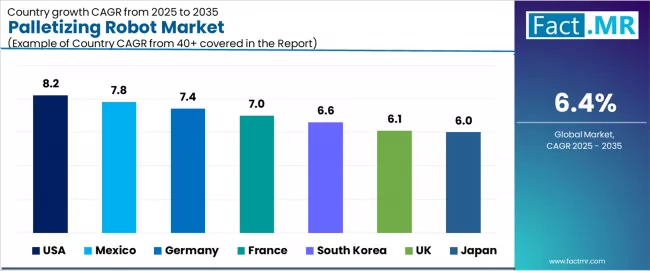
| Country | CAGR (2025-2035) |
|---|---|
| USA | 8.2% |
| Mexico | 7.8% |
| Germany | 7.4% |
| France | 7.0% |
| South Korea | 6.6% |
| UK | 6.1% |
| Japan | 6.0% |
USA Demonstrates Technology Innovation
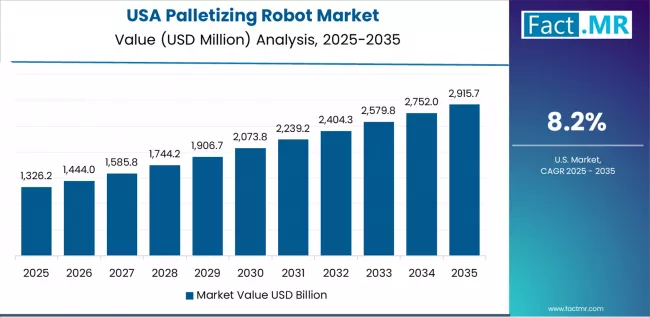
The USA market emphasizes advanced robotic features, including precision palletizing control and integration with comprehensive warehouse platforms that manage operational efficiency, cost optimization, and logistics applications through unified monitoring systems. The country demonstrates strong growth at 8.2% CAGR, driven by warehouse modernization, e-commerce initiative projects, and emerging automation applications that support palletizing robot system integration. American operators prioritize operational effectiveness with palletizing robots delivering consistent performance through advanced packaging algorithms and logistics adaptation capabilities.
Technology deployment channels include major logistics companies, specialized warehouse suppliers, and e-commerce procurement programs that support professional applications for complex warehouse and distribution applications. System integration capabilities with established logistics platforms expand market appeal across diverse operational requirements seeking packaging efficiency and productivity benefits. The resilient e-commerce sector and expanding warehouse capacity additions create sustained demand, while innovative applications in omnichannel fulfillment open new growth avenues.
Performance Metrics:
- Warehouse facilities in California, Texas, and Illinois leading adoption for automated palletizing operations
- Specialty logistics contractor channels maintaining 69% market share for complex warehouse integration applications
- Commercial e-commerce programs supporting 61% of system acquisitions across food and pharmaceutical facilities
- System compatibility with major warehouse platforms driving procurement selection criteria
Mexico Emerges as High-Growth Market
Mexico leads growth momentum with a 7.8% CAGR, driven by rapid logistics industry modernization, expanding food processing applications, and specialty warehouse development adoption across major industrial regions including Estado de México, Jalisco, and Nuevo León. Logistics industry development and warehouse requirements drive primary demand, while growing e-commerce operations and food manufacturing sectors create diversified application opportunities. Government logistics initiatives and industrial programs support sustained expansion. The convergence of logistics industry modernization, warehouse processing growth, and automation capacity expansion positions Mexico as a key emerging market for palletizing robot systems.
Strategic Market Indicators:
- Government support for logistics industry development and warehouse expansion driving demand for specialty palletizing robot processing throughout major industrial regions and logistics clusters across warehouse facilities, distribution centers, and logistics manufacturing centers
- Strong logistics sector growth and expanding network of warehouse facilities supporting rapid adoption of palletizing robot technologies among operators seeking enhanced packaging efficiency and premium logistics offerings
Germany Maintains Technology Leadership
Germany's advanced logistics market demonstrates sophisticated palletizing robot deployment with documented operational effectiveness in warehouse applications and distribution facilities through integration with existing automation systems and logistics infrastructure. The country leverages engineering expertise in robotics technology and warehouse systems integration to maintain strong growth at 7.4% CAGR. Logistics centers, including North Rhine-Westphalia, Bavaria, and Baden-Württemberg, showcase premium installations where robotic systems integrate with comprehensive warehouse platforms and logistics management systems to optimize packaging and operational effectiveness.
German logistics companies prioritize system reliability and EU compliance in robotic development, creating demand for premium packaging systems with advanced features, including operational monitoring integration and automated robotic systems. The market benefits from established logistics infrastructure and willingness to invest in advanced robotic technologies that provide long-term operational benefits and compliance with international logistics safety and quality standards. Premium food processing applications, specialty robotic systems, and e-commerce programs drive diversified demand across multiple end-use segments.
Market Intelligence Brief:
- Engineering focuses on EU standardization and logistics compliance, driving premium segment growth
- Logistics partnerships providing 42% faster development cycles
- Technology collaboration between German logistics companies and international robotic suppliers
- Packaging training programs expanding palletizing robot system integration in warehouse and distribution scenarios
France Shows Balanced Logistics Growth
France maintains steady expansion at 7.0% CAGR through diversified demand from logistics programs, specialty warehouse modernization activities, and robotic development projects. Major logistics regions in Île-de-France, Rhône-Alpes, and Nord-Pas-de-Calais drive palletizing robot adoption for commercial and industrial distribution. Logistics research and development programs create sustained robotic demand, while premium food processing applications provide additional growth opportunities. Government support for logistics innovation and warehouse quality initiatives supports consistent market development.
Market Characteristics:
- Advanced logistics research capabilities and specialty warehouse regulations creating demand for innovative robotic technologies supporting logistics development and packaging optimization
- Strong logistics tradition and warehouse excellence leadership driving adoption of premium robotic technologies and packaging systems throughout logistics facilities
South Korea Emphasizes Advanced Processing Integration
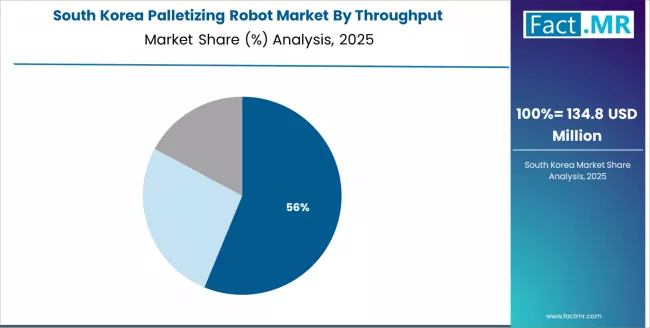
South Korea demonstrates robust market development with a 6.6% CAGR, distinguished by logistics companies and specialty warehouse producers' preference for high-quality palletizing robot systems that integrate seamlessly with existing logistics systems and provide reliable long-term operation in specialized packaging applications. The market prioritizes advanced features, including precision palletizing control, system durability, and integration with comprehensive logistics platforms that reflect Korean industry expectations for technological sophistication and operational excellence.
Growth drivers encompass advanced food processing applications, expanding logistics modernization requirements, and robotic system integration. Korean operators emphasize quality control systems and comprehensive technical support that align with domestic logistics industry standards. The convergence of high-tech manufacturing, specialty warehouse innovation, and growing food processing production creates diversified demand across multiple application segments.
Market Characteristics:
- Premium focus on food processing systems with advanced robotic algorithms and precision packaging capabilities
- Integration requirements with existing logistics processing and specialty warehouse platforms
- Emphasis on operational reliability and long-term durability in logistics and warehouse applications
UK Drives Logistics Processing and Robotic Integration
The UK market holds steady growth at 6.1% CAGR, driven by logistics processing modernization activities, specialty warehouse programs, and advanced robotic adoption trends. British logistics facilities and warehouse companies are implementing advanced palletizing robot systems to enhance operational capabilities and support logistics operations that align with industry regulations and efficiency standards. Market expansion benefits from logistics quality programs that mandate advanced robotic capabilities in specialty warehouse and food processing specifications, creating sustained demand where operational flexibility and system compliance represent critical requirements.
Strategic Market Indicators:
- Logistics processing and warehouse facilities leading adoption with modernization programs requiring advanced robotic systems
- Industry quality programs providing regulatory support for advanced robotic system acquisition
- Specialty logistics compliance requirements driving demand for standardized systems with international operational compatibility
- Specialized warehouse and premium food processing segments adopting comprehensive robotic solutions for logistics optimization
Japan Emphasizes Precision and Processing Excellence

Japan demonstrates steady market development with a 6.0% CAGR, distinguished by logistics and specialty warehouse producers' preference for high-quality palletizing robot systems that integrate seamlessly with existing logistics systems and provide reliable long-term operation in specialized packaging applications. The market prioritizes advanced features, including precision palletizing control, system durability, and integration with comprehensive logistics platforms that reflect Japanese industry expectations for technological sophistication and operational excellence.
High-specification logistics and specialty warehouse applications drive demand, supported by advanced robotic research and development initiatives. Japanese operators emphasize palletizing robot reliability, consistent performance characteristics, and comprehensive quality documentation that aligns with stringent logistics industry standards. The focus on premium applications and technical excellence supports stable growth despite mature market conditions.
Market Characteristics:
- Premium focus on food processing systems with advanced robotic algorithms and precision packaging capabilities
- Integration requirements with existing logistics processing and specialty warehouse platforms
- Emphasis on operational reliability and long-term durability in logistics and warehouse applications
Europe Market Split by Country
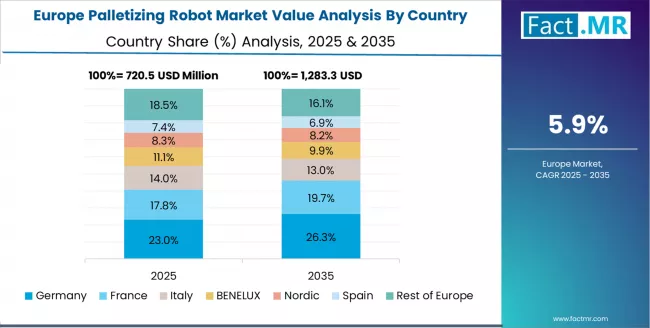
The European Palletizing Robot market is projected to grow from USD 870.0 million in 2025 to USD 1,620.0 million by 2035, registering a CAGR of 6.4% over the forecast period. Germany is expected to maintain its leadership position with a 26.4% market share in 2025, declining slightly to 26.0% by 2035, supported by its advanced logistics infrastructure and major warehouse centers in North Rhine-Westphalia and Bavaria.
France follows with a 19.8% share in 2025, projected to reach 20.2% by 2035, driven by comprehensive logistics modernization programs and specialty warehouse initiatives. UK holds a 17.2% share in 2025, expected to moderate to 16.8% by 2035 through specialized logistics activities and warehouse applications. Italy commands a 13.6% share in 2025, rising to 14.0% by 2035 through strong logistics and food processing projects. Spain accounts for 11.5% in 2025, reaching 11.8% by 2035 aided by logistics modernization and warehouse applications. Netherlands maintains a 6.1% share in 2025, increasing to 6.3% by 2035 driven by specialty logistics and innovation demand. The Rest of Europe region is anticipated to hold 5.4% in 2025, increasing to 4.9% by 2035, reflecting steady adoption in Nordic countries and Central & Eastern European logistics upgrades.
Food & Beverage Dominate Demand in Japan
In Japan, the Palletizing Robot market prioritizes food & beverage systems, which capture the dominant share of logistics and specialty warehouse installations due to their advanced features, including precision packaging optimization and seamless integration with existing food processing infrastructure. Japanese logistics operators emphasize reliability, precision, and long-term operational excellence, creating demand for food & beverage systems that provide consistent palletizing robot capabilities and adaptive performance based on packaging requirements and operational conditions.
Processing Companies Lead Logistics Services in South Korea
In South Korea, the market structure favors international processing companies, including FANUC, ABB, and KUKA, which maintain dominant positions through comprehensive product portfolios and established logistics industry networks supporting both food processing and warehouse installations. These providers offer integrated solutions combining advanced palletizing robot systems with professional application services and ongoing technical support that appeal to Korean operators seeking reliable robotic systems.
Competitive Landscape of the Palletizing Robot Market
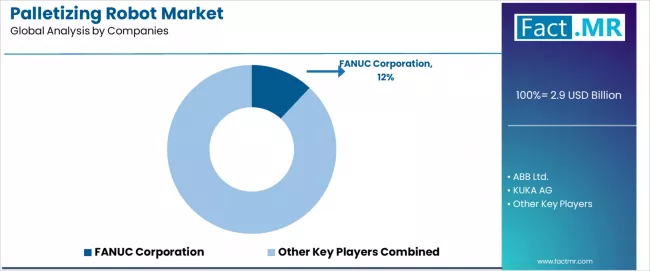
The palletizing robot market operates with moderate concentration, featuring approximately 12-15 meaningful participants, where leading companies control roughly 36-43% of the global market share through established logistics relationships and comprehensive robotic portfolios. Competition emphasizes advanced packaging capabilities, system reliability, and warehouse integration rather than price-based rivalry. The leading company, FANUC, commands approximately 12.0% market share through its specialized robotic expertise and extensive logistics and warehouse automation industry presence.
Market leaders encompass FANUC, ABB, and KUKA, which maintain competitive advantages through extensive robotic expertise, global logistics networks, and comprehensive system integration capabilities that create customer switching costs and support premium pricing. These companies leverage years of robotic technology experience and ongoing research investments to develop advanced palletizing robot systems with precision packaging control and operational monitoring features.
Technology Innovators include Yaskawa, Kawasaki, and Knapp, which compete through specialized robotic technology focus and innovative application interfaces that appeal to operators seeking advanced packaging capabilities and operational flexibility. These companies differentiate through rapid development cycles and specialized warehouse and food processing application focus.
Regional specialists feature companies like Dematic, Staubli, Mitsubishi Electric, and Adept, which focus on specific geographic markets and specialized applications. Market dynamics favor participants that combine reliable packaging capabilities with advanced application systems, including precision robotic control and automatic performance optimization capabilities.
Key Players in the Palletizing Robot Market
- FANUC Corporation
- ABB Ltd.
- KUKA AG
- Yaskawa Electric Corporation
- Kawasaki Heavy Industries, Ltd.
- KNAPP AG
- Dematic Group (a member of the KION Group)
- Stäubli International AG
- Mitsubishi Electric Corporation
- Adept Technology, Inc. (a subsidiary of Omron Corporation)
Scope of the Report
| Item | Value |
|---|---|
| Quantitative Units | USD Billion |
| Robot Type | Articulated, Delta/parallel, SCARA/gantry |
| Throughput | 30–120 pallets/day, >120, <30 |
| Industry | Food & beverage, E-commerce, Pharma |
| Regions Covered | North America, Europe, Asia Pacific, Latin America, Middle East & Africa |
| Countries Covered | USA, Germany, UK, France, Japan, South Korea, Mexico, and 15+ additional countries |
| Key Companies Profiled | FANUC, ABB, KUKA, Yaskawa, Kawasaki, Knapp, Dematic |
| Additional Attributes | Dollar sales by robot type and industry categories, regional adoption trends across North America, Europe, and Asia Pacific, competitive landscape with robotic processors and logistics suppliers, operator preferences for packaging capabilities and system reliability, integration with warehouse platforms and efficiency monitoring systems, innovations in articulated robot processing and logistics compliance, and development of automated packaging solutions with enhanced performance and warehouse optimization capabilities. |
Palletizing Robot Market by Segments
-
Robot Type :
- Articulated
- Delta/Parallel
- SCARA/Gantry
-
Throughput :
- 30–120 Pallets/Day
- 120
- <30
-
Industry :
- Food & Beverage
- E-commerce
- Pharma
-
Region :
- North America
- USA
- Canada
- Mexico
- Europe
- Germany
- France
- UK
- Italy
- Spain
- Netherlands
- Nordic
- Rest of Europe
- Asia Pacific
- Japan
- South Korea
- China
- India
- ASEAN
- Australia & New Zealand
- Rest of Asia Pacific
- Latin America
- Brazil
- Argentina
- Rest of Latin America
- Middle East & Africa
- GCC Countries
- South Africa
- Rest of Middle East & Africa
- North America
Table of Content
- Executive Summary
- Global Market Outlook
- Demand to side Trends
- Supply to side Trends
- Technology Roadmap Analysis
- Analysis and Recommendations
- Market Overview
- Market Coverage / Taxonomy
- Market Definition / Scope / Limitations
- Market Background
- Market Dynamics
- Drivers
- Restraints
- Opportunity
- Trends
- Scenario Forecast
- Demand in Optimistic Scenario
- Demand in Likely Scenario
- Demand in Conservative Scenario
- Opportunity Map Analysis
- Product Life Cycle Analysis
- Supply Chain Analysis
- Investment Feasibility Matrix
- Value Chain Analysis
- PESTLE and Porter’s Analysis
- Regulatory Landscape
- Regional Parent Market Outlook
- Production and Consumption Statistics
- Import and Export Statistics
- Market Dynamics
- Global Market Analysis 2020 to 2024 and Forecast, 2025 to 2035
- Historical Market Size Value (USD Million) Analysis, 2020 to 2024
- Current and Future Market Size Value (USD Million) Projections, 2025 to 2035
- Y to o to Y Growth Trend Analysis
- Absolute $ Opportunity Analysis
- Global Market Pricing Analysis 2020 to 2024 and Forecast 2025 to 2035
- Global Market Analysis 2020 to 2024 and Forecast 2025 to 2035, By Robot Type
- Introduction / Key Findings
- Historical Market Size Value (USD Million) Analysis By Robot Type , 2020 to 2024
- Current and Future Market Size Value (USD Million) Analysis and Forecast By Robot Type , 2025 to 2035
- Articulated
- Delta/Parallel
- SCARA/Gantry
- Y to o to Y Growth Trend Analysis By Robot Type , 2020 to 2024
- Absolute $ Opportunity Analysis By Robot Type , 2025 to 2035
- Global Market Analysis 2020 to 2024 and Forecast 2025 to 2035, By Throughput
- Introduction / Key Findings
- Historical Market Size Value (USD Million) Analysis By Throughput, 2020 to 2024
- Current and Future Market Size Value (USD Million) Analysis and Forecast By Throughput, 2025 to 2035
- 30–120 Pallets/Day
- 120
- <30
- Y to o to Y Growth Trend Analysis By Throughput, 2020 to 2024
- Absolute $ Opportunity Analysis By Throughput, 2025 to 2035
- Global Market Analysis 2020 to 2024 and Forecast 2025 to 2035, By Region
- Introduction
- Historical Market Size Value (USD Million) Analysis By Region, 2020 to 2024
- Current Market Size Value (USD Million) Analysis and Forecast By Region, 2025 to 2035
- North America
- Latin America
- Western Europe
- Eastern Europe
- East Asia
- South Asia and Pacific
- Middle East & Africa
- Market Attractiveness Analysis By Region
- North America Market Analysis 2020 to 2024 and Forecast 2025 to 2035, By Country
- Historical Market Size Value (USD Million) Trend Analysis By Market Taxonomy, 2020 to 2024
- Market Size Value (USD Million) Forecast By Market Taxonomy, 2025 to 2035
- By Country
- USA
- Canada
- Mexico
- By Robot Type
- By Throughput
- By Country
- Market Attractiveness Analysis
- By Country
- By Robot Type
- By Throughput
- Key Takeaways
- Latin America Market Analysis 2020 to 2024 and Forecast 2025 to 2035, By Country
- Historical Market Size Value (USD Million) Trend Analysis By Market Taxonomy, 2020 to 2024
- Market Size Value (USD Million) Forecast By Market Taxonomy, 2025 to 2035
- By Country
- Brazil
- Chile
- Rest of Latin America
- By Robot Type
- By Throughput
- By Country
- Market Attractiveness Analysis
- By Country
- By Robot Type
- By Throughput
- Key Takeaways
- Western Europe Market Analysis 2020 to 2024 and Forecast 2025 to 2035, By Country
- Historical Market Size Value (USD Million) Trend Analysis By Market Taxonomy, 2020 to 2024
- Market Size Value (USD Million) Forecast By Market Taxonomy, 2025 to 2035
- By Country
- Germany
- UK
- Italy
- Spain
- France
- Nordic
- BENELUX
- Rest of Western Europe
- By Robot Type
- By Throughput
- By Country
- Market Attractiveness Analysis
- By Country
- By Robot Type
- By Throughput
- Key Takeaways
- Eastern Europe Market Analysis 2020 to 2024 and Forecast 2025 to 2035, By Country
- Historical Market Size Value (USD Million) Trend Analysis By Market Taxonomy, 2020 to 2024
- Market Size Value (USD Million) Forecast By Market Taxonomy, 2025 to 2035
- By Country
- Russia
- Poland
- Hungary
- Balkan & Baltic
- Rest of Eastern Europe
- By Robot Type
- By Throughput
- By Country
- Market Attractiveness Analysis
- By Country
- By Robot Type
- By Throughput
- Key Takeaways
- East Asia Market Analysis 2020 to 2024 and Forecast 2025 to 2035, By Country
- Historical Market Size Value (USD Million) Trend Analysis By Market Taxonomy, 2020 to 2024
- Market Size Value (USD Million) Forecast By Market Taxonomy, 2025 to 2035
- By Country
- China
- Japan
- South Korea
- By Robot Type
- By Throughput
- By Country
- Market Attractiveness Analysis
- By Country
- By Robot Type
- By Throughput
- Key Takeaways
- South Asia and Pacific Market Analysis 2020 to 2024 and Forecast 2025 to 2035, By Country
- Historical Market Size Value (USD Million) Trend Analysis By Market Taxonomy, 2020 to 2024
- Market Size Value (USD Million) Forecast By Market Taxonomy, 2025 to 2035
- By Country
- India
- ASEAN
- Australia & New Zealand
- Rest of South Asia and Pacific
- By Robot Type
- By Throughput
- By Country
- Market Attractiveness Analysis
- By Country
- By Robot Type
- By Throughput
- Key Takeaways
- Middle East & Africa Market Analysis 2020 to 2024 and Forecast 2025 to 2035, By Country
- Historical Market Size Value (USD Million) Trend Analysis By Market Taxonomy, 2020 to 2024
- Market Size Value (USD Million) Forecast By Market Taxonomy, 2025 to 2035
- By Country
- Kingdom of Saudi Arabia
- Other GCC Countries
- Turkiye
- South Africa
- Other African Union
- Rest of Middle East & Africa
- By Robot Type
- By Throughput
- By Country
- Market Attractiveness Analysis
- By Country
- By Robot Type
- By Throughput
- Key Takeaways
- Key Countries Market Analysis
- USA
- Pricing Analysis
- Market Share Analysis, 2024
- By Robot Type
- By Throughput
- Canada
- Pricing Analysis
- Market Share Analysis, 2024
- By Robot Type
- By Throughput
- Mexico
- Pricing Analysis
- Market Share Analysis, 2024
- By Robot Type
- By Throughput
- Brazil
- Pricing Analysis
- Market Share Analysis, 2024
- By Robot Type
- By Throughput
- Chile
- Pricing Analysis
- Market Share Analysis, 2024
- By Robot Type
- By Throughput
- Germany
- Pricing Analysis
- Market Share Analysis, 2024
- By Robot Type
- By Throughput
- UK
- Pricing Analysis
- Market Share Analysis, 2024
- By Robot Type
- By Throughput
- Italy
- Pricing Analysis
- Market Share Analysis, 2024
- By Robot Type
- By Throughput
- Spain
- Pricing Analysis
- Market Share Analysis, 2024
- By Robot Type
- By Throughput
- France
- Pricing Analysis
- Market Share Analysis, 2024
- By Robot Type
- By Throughput
- India
- Pricing Analysis
- Market Share Analysis, 2024
- By Robot Type
- By Throughput
- ASEAN
- Pricing Analysis
- Market Share Analysis, 2024
- By Robot Type
- By Throughput
- Australia & New Zealand
- Pricing Analysis
- Market Share Analysis, 2024
- By Robot Type
- By Throughput
- China
- Pricing Analysis
- Market Share Analysis, 2024
- By Robot Type
- By Throughput
- Japan
- Pricing Analysis
- Market Share Analysis, 2024
- By Robot Type
- By Throughput
- South Korea
- Pricing Analysis
- Market Share Analysis, 2024
- By Robot Type
- By Throughput
- Russia
- Pricing Analysis
- Market Share Analysis, 2024
- By Robot Type
- By Throughput
- Poland
- Pricing Analysis
- Market Share Analysis, 2024
- By Robot Type
- By Throughput
- Hungary
- Pricing Analysis
- Market Share Analysis, 2024
- By Robot Type
- By Throughput
- Kingdom of Saudi Arabia
- Pricing Analysis
- Market Share Analysis, 2024
- By Robot Type
- By Throughput
- Turkiye
- Pricing Analysis
- Market Share Analysis, 2024
- By Robot Type
- By Throughput
- South Africa
- Pricing Analysis
- Market Share Analysis, 2024
- By Robot Type
- By Throughput
- USA
- Market Structure Analysis
- Competition Dashboard
- Competition Benchmarking
- Market Share Analysis of Top Players
- By Regional
- By Robot Type
- By Throughput
- Competition Analysis
- Competition Deep Dive
- FANUC Corporation
- Overview
- Product Portfolio
- Profitability by Market Segments (Product/Age /Sales Channel/Region)
- Sales Footprint
- Strategy Overview
- Marketing Strategy
- Product Strategy
- Channel Strategy
- ABB Ltd.
- KUKA AG
- Yaskawa Electric Corporation
- Kawasaki Heavy Industries, Ltd.
- KNAPP AG
- Dematic Group (a member of the KION Group)
- Stäubli International AG
- Mitsubishi Electric Corporation
- Adept Technology, Inc. (a subsidiary of Omron Corporation)
- FANUC Corporation
- Competition Deep Dive
- Assumptions & Acronyms Used
- Research Methodology
List Of Table
- Table 1: Global Market Value (USD Million) Forecast by Region, 2020 to 2035
- Table 2: Global Market Value (USD Million) Forecast by Robot Type , 2020 to 2035
- Table 3: Global Market Value (USD Million) Forecast by Throughput, 2020 to 2035
- Table 4: North America Market Value (USD Million) Forecast by Country, 2020 to 2035
- Table 5: North America Market Value (USD Million) Forecast by Robot Type , 2020 to 2035
- Table 6: North America Market Value (USD Million) Forecast by Throughput, 2020 to 2035
- Table 7: Latin America Market Value (USD Million) Forecast by Country, 2020 to 2035
- Table 8: Latin America Market Value (USD Million) Forecast by Robot Type , 2020 to 2035
- Table 9: Latin America Market Value (USD Million) Forecast by Throughput, 2020 to 2035
- Table 10: Western Europe Market Value (USD Million) Forecast by Country, 2020 to 2035
- Table 11: Western Europe Market Value (USD Million) Forecast by Robot Type , 2020 to 2035
- Table 12: Western Europe Market Value (USD Million) Forecast by Throughput, 2020 to 2035
- Table 13: Eastern Europe Market Value (USD Million) Forecast by Country, 2020 to 2035
- Table 14: Eastern Europe Market Value (USD Million) Forecast by Robot Type , 2020 to 2035
- Table 15: Eastern Europe Market Value (USD Million) Forecast by Throughput, 2020 to 2035
- Table 16: East Asia Market Value (USD Million) Forecast by Country, 2020 to 2035
- Table 17: East Asia Market Value (USD Million) Forecast by Robot Type , 2020 to 2035
- Table 18: East Asia Market Value (USD Million) Forecast by Throughput, 2020 to 2035
- Table 19: South Asia and Pacific Market Value (USD Million) Forecast by Country, 2020 to 2035
- Table 20: South Asia and Pacific Market Value (USD Million) Forecast by Robot Type , 2020 to 2035
- Table 21: South Asia and Pacific Market Value (USD Million) Forecast by Throughput, 2020 to 2035
- Table 22: Middle East & Africa Market Value (USD Million) Forecast by Country, 2020 to 2035
- Table 23: Middle East & Africa Market Value (USD Million) Forecast by Robot Type , 2020 to 2035
- Table 24: Middle East & Africa Market Value (USD Million) Forecast by Throughput, 2020 to 2035
List Of Figures
- Figure 1: Global Market Pricing Analysis
- Figure 2: Global Market Value (USD Million) Forecast 2020-2035
- Figure 3: Global Market Value Share and BPS Analysis by Robot Type , 2025 and 2035
- Figure 4: Global Market Y to o to Y Growth Comparison by Robot Type , 2025-2035
- Figure 5: Global Market Attractiveness Analysis by Robot Type
- Figure 6: Global Market Value Share and BPS Analysis by Throughput, 2025 and 2035
- Figure 7: Global Market Y to o to Y Growth Comparison by Throughput, 2025-2035
- Figure 8: Global Market Attractiveness Analysis by Throughput
- Figure 9: Global Market Value (USD Million) Share and BPS Analysis by Region, 2025 and 2035
- Figure 10: Global Market Y to o to Y Growth Comparison by Region, 2025-2035
- Figure 11: Global Market Attractiveness Analysis by Region
- Figure 12: North America Market Incremental Dollar Opportunity, 2025-2035
- Figure 13: Latin America Market Incremental Dollar Opportunity, 2025-2035
- Figure 14: Western Europe Market Incremental Dollar Opportunity, 2025-2035
- Figure 15: Eastern Europe Market Incremental Dollar Opportunity, 2025-2035
- Figure 16: East Asia Market Incremental Dollar Opportunity, 2025-2035
- Figure 17: South Asia and Pacific Market Incremental Dollar Opportunity, 2025-2035
- Figure 18: Middle East & Africa Market Incremental Dollar Opportunity, 2025-2035
- Figure 19: North America Market Value Share and BPS Analysis by Country, 2025 and 2035
- Figure 20: North America Market Value Share and BPS Analysis by Robot Type , 2025 and 2035
- Figure 21: North America Market Y to o to Y Growth Comparison by Robot Type , 2025-2035
- Figure 22: North America Market Attractiveness Analysis by Robot Type
- Figure 23: North America Market Value Share and BPS Analysis by Throughput, 2025 and 2035
- Figure 24: North America Market Y to o to Y Growth Comparison by Throughput, 2025-2035
- Figure 25: North America Market Attractiveness Analysis by Throughput
- Figure 26: Latin America Market Value Share and BPS Analysis by Country, 2025 and 2035
- Figure 27: Latin America Market Value Share and BPS Analysis by Robot Type , 2025 and 2035
- Figure 28: Latin America Market Y to o to Y Growth Comparison by Robot Type , 2025-2035
- Figure 29: Latin America Market Attractiveness Analysis by Robot Type
- Figure 30: Latin America Market Value Share and BPS Analysis by Throughput, 2025 and 2035
- Figure 31: Latin America Market Y to o to Y Growth Comparison by Throughput, 2025-2035
- Figure 32: Latin America Market Attractiveness Analysis by Throughput
- Figure 33: Western Europe Market Value Share and BPS Analysis by Country, 2025 and 2035
- Figure 34: Western Europe Market Value Share and BPS Analysis by Robot Type , 2025 and 2035
- Figure 35: Western Europe Market Y to o to Y Growth Comparison by Robot Type , 2025-2035
- Figure 36: Western Europe Market Attractiveness Analysis by Robot Type
- Figure 37: Western Europe Market Value Share and BPS Analysis by Throughput, 2025 and 2035
- Figure 38: Western Europe Market Y to o to Y Growth Comparison by Throughput, 2025-2035
- Figure 39: Western Europe Market Attractiveness Analysis by Throughput
- Figure 40: Eastern Europe Market Value Share and BPS Analysis by Country, 2025 and 2035
- Figure 41: Eastern Europe Market Value Share and BPS Analysis by Robot Type , 2025 and 2035
- Figure 42: Eastern Europe Market Y to o to Y Growth Comparison by Robot Type , 2025-2035
- Figure 43: Eastern Europe Market Attractiveness Analysis by Robot Type
- Figure 44: Eastern Europe Market Value Share and BPS Analysis by Throughput, 2025 and 2035
- Figure 45: Eastern Europe Market Y to o to Y Growth Comparison by Throughput, 2025-2035
- Figure 46: Eastern Europe Market Attractiveness Analysis by Throughput
- Figure 47: East Asia Market Value Share and BPS Analysis by Country, 2025 and 2035
- Figure 48: East Asia Market Value Share and BPS Analysis by Robot Type , 2025 and 2035
- Figure 49: East Asia Market Y to o to Y Growth Comparison by Robot Type , 2025-2035
- Figure 50: East Asia Market Attractiveness Analysis by Robot Type
- Figure 51: East Asia Market Value Share and BPS Analysis by Throughput, 2025 and 2035
- Figure 52: East Asia Market Y to o to Y Growth Comparison by Throughput, 2025-2035
- Figure 53: East Asia Market Attractiveness Analysis by Throughput
- Figure 54: South Asia and Pacific Market Value Share and BPS Analysis by Country, 2025 and 2035
- Figure 55: South Asia and Pacific Market Value Share and BPS Analysis by Robot Type , 2025 and 2035
- Figure 56: South Asia and Pacific Market Y to o to Y Growth Comparison by Robot Type , 2025-2035
- Figure 57: South Asia and Pacific Market Attractiveness Analysis by Robot Type
- Figure 58: South Asia and Pacific Market Value Share and BPS Analysis by Throughput, 2025 and 2035
- Figure 59: South Asia and Pacific Market Y to o to Y Growth Comparison by Throughput, 2025-2035
- Figure 60: South Asia and Pacific Market Attractiveness Analysis by Throughput
- Figure 61: Middle East & Africa Market Value Share and BPS Analysis by Country, 2025 and 2035
- Figure 62: Middle East & Africa Market Value Share and BPS Analysis by Robot Type , 2025 and 2035
- Figure 63: Middle East & Africa Market Y to o to Y Growth Comparison by Robot Type , 2025-2035
- Figure 64: Middle East & Africa Market Attractiveness Analysis by Robot Type
- Figure 65: Middle East & Africa Market Value Share and BPS Analysis by Throughput, 2025 and 2035
- Figure 66: Middle East & Africa Market Y to o to Y Growth Comparison by Throughput, 2025-2035
- Figure 67: Middle East & Africa Market Attractiveness Analysis by Throughput
- Figure 68: Global Market - Tier Structure Analysis
- Figure 69: Global Market - Company Share Analysis
- FAQs -
How big is the palletizing robot market in 2025?
The global palletizing robot market is estimated to be valued at USD 2.9 billion in 2025.
What will be the size of palletizing robot market in 2035?
The market size for the palletizing robot market is projected to reach USD 5.4 billion by 2035.
How much will be the palletizing robot market growth between 2025 and 2035?
The palletizing robot market is expected to grow at a 6.4% CAGR between 2025 and 2035.
What are the key product types in the palletizing robot market?
The key product types in palletizing robot market are articulated, delta/parallel and scara/gantry.
Which throughput segment to contribute significant share in the palletizing robot market in 2025?
In terms of throughput, 30–120 pallets/day segment to command 54.0% share in the palletizing robot market in 2025.